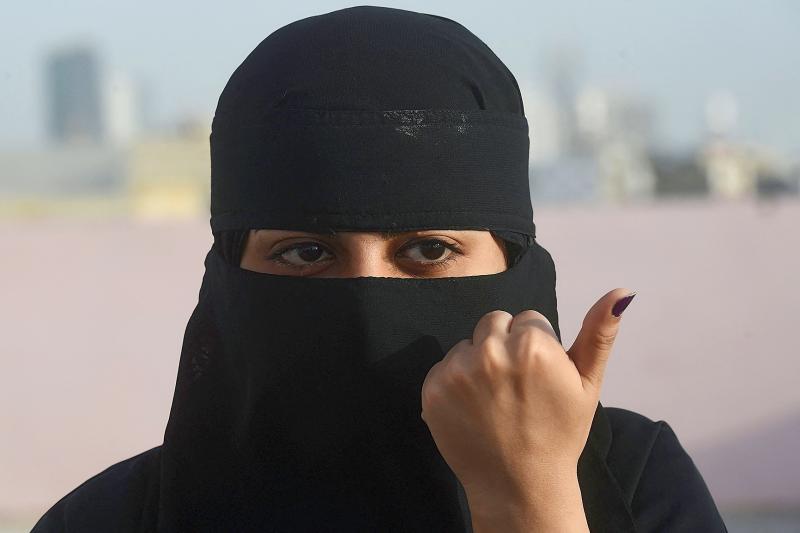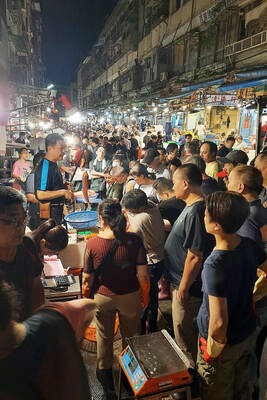Pakistan’s breakthrough rapper Eva B has racked up millions of views online, but walking through the labyrinthine streets of her Karachi neighbourhood, she is anonymous. Her hair covered with a hijab and a veil falling below her eyes, she evades the attention of fans and detractors.
“It’s funny that people don’t recognize me, they play my songs but when I’m in front of them they don’t know it’s me,” the 22-year-old said from a rooftop overlooking the mega port city of Karachi.
Inspired by American rappers Eminem and Queen Latifah, she started writing lyrics from her bedroom and posting her raps to Facebook where she built up a following.

Photo: AFP
Afraid of angering her family, she would sneak to music studios to record full tracks with the help of other emerging artists in her neighborhood, under the pretext of studying.
But when word reached her brother, she received a backlash from her family who considered the genre indecent for a young girl and who feared she would struggle to marry in deeply conservative Pakistan.
“Later they realized that I was quite persistent, so they surrendered. They realized I couldn’t be stopped,” she laughed, adding that her mother now supports her in the studio and on set.

Photo: AFP
Eva B’s rise to fame was accelerated this year when Coca-Cola’s international music franchise Coke Studios — one of the most popular television programs in Pakistan — invited her collaborate for its 2022 series.
The music video for Kana Yaari, which features Eva B rapping in a bright orange hijab about the betrayal of a love interest, has more than 16 million views on YouTube.
But unlike other artists in the series, she has shunned a celebrity status.
“It is strange to live two lives. People know me, but at the same time they don’t really know me,” she said. She finds it amusing to nod along to conversations in cafes or at friends’ weddings when people talk about the latest track from Eva B.
On rare occasions, she says people recognize her from her eyes, but she always denies her stage identity.
“I’m okay with what I am. I can’t handle everybody,” she says of the attention from media and fans she would otherwise attract.
INDUSTRY ‘ASTONISHED’ BY HIJAB
Most women wear some form of hijab covering in Muslim-majority Pakistan but there are very few music artists in local pop culture who are veiled. Turning up to studios for the first time, industry producers and managers were often left “astonished,” she said.
“They reacted like ‘what is this?’” she said. “But then everything soon becomes normal.”
For Eva B, the hijab has always been a proud part of her Muslim identity — but it has also defined her image as a rapper.
“These days I wear more stylish clothes for the music videos so I stand out. But even then I always wear my hijab,” she said, adding that she sometimes swaps the face veil for a pandemic-era mask.
She has, however, grown weary of the conversation around how she dresses.
“The media has focused on my hijab rather than me... they do it for hype,” she said. “It’s normal in my society. Don’t let it be breaking news.”
What does delight her are the stream of Instagram messages from girls and women thrilled to see a woman in a hijab represented in mainstream media.
“I feel happy that I inspire them... that they feel proud of me,” she said. But as a woman rapper in a hijab, disapproval for not being “a good girl” is never far away, she says.
“There is nothing harmful in what I am doing, I openly sing songs and there is nothing bad in that.”
STRAIGHT OUTTA KARACHI
Eva B grew up in Lyari, a Karachi neighborhood haunted by gang violence and poverty for decades and once considered one of Pakistan’s most dangerous areas, but which inspired a generation of artists and spawned a burgeoning hip hop scene.
With its close proximity to the sea and history of smuggling, the largely ethnic Balochi neighbourhood in Karachi stands apart for its history of violence and lawlessness — even by Pakistan’s standards.
But the worst of the violence has abated, and an increase in security has led to flowering creativity.
The embattled neighborhood now clings fiercely to its reputation for producing top footballers, iron-chinned boxers and most recently socially conscious rappers.
“We didn’t attend any prestigious music schools, we learned everything ourselves, driven by our passion. So I keep highlighting Lyari and I’m proud of it,” she said.
The rise of hip hop in Lyari mirrors the genre’s birth decades ago in New York’s Bronx borough, where it largely centered around street performances and featured lyrics that addressed social ills and life in urban ghettos.
Eva B also speaks straightforwardly about the difficulties women face and the disparity in wealth in Pakistan, and even the sensitive issue of local corruption.
Her favorite song, Bayani Rog, in her native Balochi language, tells the story of her evolution from shy, nervous teenager to the self-assured, frank woman she is today.
“I realized that keeping silent won’t work, so I better speak up,” she said.

The Taipei Times last week reported that the rising share of seniors in the population is reshaping the nation’s housing markets. According to data from the Ministry of the Interior, about 850,000 residences were occupied by elderly people in the first quarter, including 655,000 that housed only one resident. H&B Realty chief researcher Jessica Hsu (徐佳馨), quoted in the article, said that there is rising demand for elderly-friendly housing, including units with elevators, barrier-free layouts and proximity to healthcare services. Hsu and others cited in the article highlighted the changing family residential dynamics, as children no longer live with parents,

It is jarring how differently Taiwan’s politics is portrayed in the international press compared to the local Chinese-language press. Viewed from abroad, Taiwan is seen as a geopolitical hotspot, or “The Most Dangerous Place on Earth,” as the Economist once blazoned across their cover. Meanwhile, tasked with facing down those existential threats, Taiwan’s leaders are dying their hair pink. These include former president Tsai Ing-wen (蔡英文), Vice President Hsiao Bi-khim (蕭美琴) and Kaohsiung Mayor Chen Chi-mai (陳其邁), among others. They are demonstrating what big fans they are of South Korean K-pop sensations Blackpink ahead of their concerts this weekend in Kaohsiung.

Taiwan is one of the world’s greatest per-capita consumers of seafood. Whereas the average human is thought to eat around 20kg of seafood per year, each Taiwanese gets through 27kg to 35kg of ocean delicacies annually, depending on which source you find most credible. Given the ubiquity of dishes like oyster omelet (蚵仔煎) and milkfish soup (虱目魚湯), the higher estimate may well be correct. By global standards, let alone local consumption patterns, I’m not much of a seafood fan. It’s not just a matter of taste, although that’s part of it. What I’ve read about the environmental impact of the

Oct 20 to Oct 26 After a day of fighting, the Japanese Army’s Second Division was resting when a curious delegation of two Scotsmen and 19 Taiwanese approached their camp. It was Oct. 20, 1895, and the troops had reached Taiye Village (太爺庄) in today’s Hunei District (湖內), Kaohsiung, just 10km away from their final target of Tainan. Led by Presbyterian missionaries Thomas Barclay and Duncan Ferguson, the group informed the Japanese that resistance leader Liu Yung-fu (劉永福) had fled to China the previous night, leaving his Black Flag Army fighters behind and the city in chaos. On behalf of the